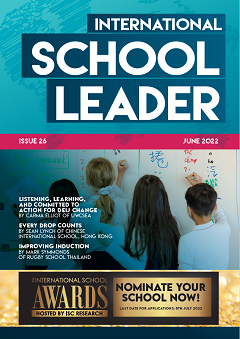By Sanah Batta
The latest data on child abuse shows that over 1 billion children between the ages of two and 17 experience violence every year, but the numbers could be much larger due to under-reporting. Violence against children can take many forms, such as physical, emotional, sexual and online abuse. It is mostly perpetrated by someone who has emotional and physical proximity to the child, which means, the perpetrator is close to the child and could be a family member, a relative, a friend or a caregiver. While violence against children is often invisible, its impact has lifelong consequences on the health and wellbeing of children, families, communities and nations. Due to the vulnerable age of a child and complexities surrounding child abuse, most cases go unreported, leaving children to deal with the consequences on their own.
As an advocate and promoter of a school in New Delhi, India, I ask myself whether schools, communities and governments are doing enough to prevent and protect children from abuse and violence. Irrespective of which country we reside in, or what nationality we are, child abuse is a universal problem and investing in protecting children from violence and abuse must become a global priority. As per the latest UNICEF data, there are nearly 2.4 billion children below the age of 18 in the world, of which, 431,053,832 are in India. Much more needs to be done to formulate local laws and policies, raise awareness and sensitisation, conduct timely and efficient capacity building programmes, and strengthen welfare systems and response services.
A child spends a substantial amount of time of their day in school. Educators, who have the opportunity to closely observe and interact with children, are in a unique position to identify those who are in need of help and protection. This can help to ensure that children receive timely support and the assistance they require, and families can obtain services that will remedy situations posing a threat to the child’s welfare.
As school leaders and educators, it is important to reflect on the mechanisms and protocols we put in place to address child abuse and violence. Differences arise due to demographic factors, local legislation, school structures and boards, but the ultimate aim remains the same – to ensure an effective, efficient and transparent prevention and protection system to address child abuse and violence.
My training in law and professional experience of running a K-12 school in India enables me to train educators, sensitise parents and work with government agencies to help enforce child protection laws, design frameworks for schools and bring about systemic change.
In my experience, no matter how well written and clear the statutory laws or how cooperative the police agencies are, I often find schools asking complex legal questions in the midst of a crisis. From understanding the legal language, addressing peer-on-peer abuse, coping with parental denial/pressure and dealing with media trials, school leaders find it exceedingly challenging to handle safeguarding cases.
Irrespective of which country we reside in, or what nationality we are, child abuse is a universal problem and investing in protecting children from violence and abuse must become a global priority.
The challenges
There are multiple challenges faced by schools and school leaders all over the world when formulating strategies for child protection and safeguarding. I have listed a few below:
- Implementation of laws: the challenge lies in implementing the laws due to lack of awareness and sensitisation, inadequate human resources and absence of quality prevention and rehabilitation services. This coupled with cultural and social differences poses a great threat to proper implementation of child protection laws. There are many harmful practices, such as child marriage, child labour and corporal punishment, which are still prevalent in spite of legislation prohibiting it. As a result, millions of children continue to be subject to many forms of violence, abuse and exploitation.
- Increased exposure to online material: the internet is a vast space with limitless information and content. Inevitably, children are exposed to adult/ inappropriate material which may lead to exploitation. The industry, governments, schools and parents have a role to play in keeping children safe online. There is a need for stricter protocols on content regulation and age verification checks.
- Staff recruitment and training: a school is home to staff and students from culturally diverse backgrounds. Knowledge and training depend on the experiences and exposure a person has had. Without proper and regular training and sensitisation, it is difficult for schools to ensure compliance and implementation of local laws. In my opinion this is the biggest challenge faced by schools.
- COVID-19 challenges: studying from home, online classes, isolation and loss of loved ones has resulted in many socio-emotional challenges, leading to behavioural concerns. This has led to an increase in peer-on-peer abuse, aggression and bullying, making enforcement of school rules as well as local laws a growing problem for schools.
- Counselling support: from the moment a child undergoes an incident of abuse until just relief is achieved (which may or may not happen), the child relives that incident many times in their mind. It is difficult for anyone to comprehend the emotional trauma that the child experiences. We must ask ourselves how a school addresses the psychological impact of violence and child abuse. Is the support we provide as an educational institution adept at addressing the trauma and turmoil the child experiences? Many times, counsellors are the first ones to hear about abuse/violence. Students and families rely heavily on the counsellor for support and guidance to help them navigate the after-effects of trauma and abuse.
- Whole school approach: looking at abuse and child protection in isolation has led to schools implementing policies on paper or being reactionary in their approach. Child protection and safeguarding does not just mean drafting a child protection policy in school. It is a revamp of the whole school’s vision and mission. Every aspect of the school and the teaching-learning process must embody aspects of protection and safeguarding. Whether it is looking at infrastructure, disability or curriculum, all components of a school environment need to align with the ethos of child protection and safeguarding.
The way forward
It is difficult to have a foolproof framework free from loopholes and flaws. Abuse may occur despite the legislation, policies, rules and regulations. However, it is our responsibility as educators to protect our students. We must prepare and empower ourselves to prevent and manage abuse and ensure our staff is trained and students feel protected. Some of the key areas to work on are highlighted below:
- Implementation of local laws and policies: the school administration (with the help of a lawyer) must ensure that requisite safety checks, protocols and compliances are in place and enforced.
- Training and capacity building: ensure all staff members are familiar with their legal obligations, such as mandatory reporting under the laws of your country. Train them on indicators and signs of abuse.
- Parental involvement: sensitise parents on types of abuse, online exposure and the importance of open and transparent lines of communication.
- Reflect on best practices: there are varying standards and practices across jurisdictions. This can help build a repository of best practices to cope with difficult situations and scenarios.
- Documentation and tracking: it is essential to keep everything documented and recorded. Safety checklists, CCTV footage, committee minutes, etc, are useful when investigating a case.
- Student voice: empower students to recognise different forms of abuse. Educate them on hotline numbers, agencies or any other platforms that are available to them for reporting and support.

Sanah Batta is Legal Practitioner and Promoter of Bloom Public School, New Delhi, India, and a Child Protection Specialist. Connect with Sanah on LinkedIn.



